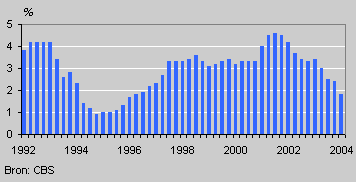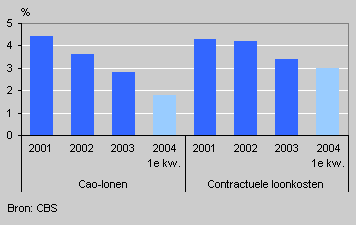Wage costs rise by more than collectively agreed wages

Collectively agreed wages in the Netherlands rose by 1.8 percent in the first quarter of this year. In 2003 the wage increase was 2.8 percent on average. The increase in collectively agreed wages has not been this low since 1996. The rise in wage costs on the other hand, fell more slowly. This was caused by higher employer-paid premiums for pensions and unemployment.
Collectively agreed wage increase above zero
In the agreement negotiated in the autumn of 2003, employers and employee organisation called for a wage freeze in 2004. As agreements for 2004 had already been negotiated earlier in some sectors, a wage increase of 1.8 percent resulted between the first quarter of 2003 and the first quarter of 2004.
Collectively agreed wage increases, 1992-2004

Not much use has been made of the possibility of agreeing to pay one-off bonuses instead of structural wage increases. The collectively agreed wages including special payments rose by just as much as collectively agreed wages excluding special payments. On balance, then, the special payments have remained unchanged.
Wage costs for employers
For an enterprise, wage costs consist of gross wages and employer-paid contributions to social insurance schemes. The latter include employer-paid premiums for pension, early retirement, unemployment, and costs related to illness and disability of employees. On average, the total wage costs are one quarter higher than the gross wages paid to employees.
Contractual wage costs rise by 3 percent
The contractual wage costs have risen faster than collectively agreed wages in recent years. Both in 2002 and in 2003 the rise in wage costs was 0.6 percent higher than the increase in collectively agreed wages. In the first quarter of 2004 the 3 percent wage cost increase was even 1.2 percent higher. The higher employer premiums for pensions and unemployment curbed the restraint in wage costs.
Collectively agreed wages and contractual wage costs

The rise in wage costs was largest in the government sector. Both in 2002 and in 2003 contractual wage costs in this sector rose by 1.5 percent more than for private companies. In the first quarter of 2004 this difference was smaller. Government sector wage costs rose by 3.8 percent, while those in the private sector rose by 2.9 percent.
Han van den Berg